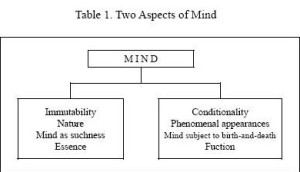To this very day there is little consensus as to the precise-relationship between tathagatā-garbha and alaya-vijñāna. Seong-Uk Kin, in his excellent extract, “Understanding Tsung-mi’s View on Buddha Nature”, nicely extrapolates on its evolving traits. The concept of alaya-vijñāna first appeared in the Samdhinirmocana-sūtra, circa early 4th century C.E. in India. This Sutra asserts that the alaya-vijñāna is a form of consciousness that exhibits particular modes of perception. It is here that it also takes on the familiar metaphorical-shape as a receptacle that house seeds of karma as well as the propensity for all future karma. It is essentially based on this understanding that Yogācāra Buddhists determine how all phenomenal-diversity develops; indeed, for them alaya-vijñāna is the hallmark for all conventional realities, and it is how subjective-agents interact in their environment. For Chinese Buddhists, their main concern was how tathagatāgarbha and alaya-vijñāna differed, especially pertaining as to whether alaya-vijñāna was pure or impure. The great Translator in China, Paramartha, asserted that it was defiled-garbha. As time progressed the Chinese developed their own unique Yogācāra schools that particularly focused on this concern. Fa-shang (495-580) represented one of these schools and expounded that tathagatāgarbha and alaya-vijñāna were exclusively separate from one another: alaya-vijñāna was totally impure and existed solely to house all karmic and phenomenal-based associations; whereas the tathagatāgarbha was solely “pure” and the ultimate source for all there is. This stood in stark contrast to other Yogācāra schools that asserted that alaya-vijñāna in-itself was pure and the sustainer of all phenomena—it was completely synonymous with the tathagatāgarbha . In a masterstroke of providing the middle-ground for all these opposing schools, the Awakening of Faith integrated both concepts: alaya-vijñāna was bifurcated as epistemologically a combination of both pure and impure aspects of consciousness, while ontologically it was not distinct from tathagatāgarbha. When in awakened-mode the alaya was pure; when in delusion, it was impure. The following diagram (from Seong-Uk Kin’s extract), depicts how the Awakening of Faith harmonized tathagatāgarbha and alaya-vijñāna as the “One Mind in Two Aspects”:
We will now explore how Tsung-mi sided with the Awakening of Faith, a salient Mahayana Doctrine that also played a principal role in his own doctrinal formulations. Tsung-mi’s Chan Prolegomenon extrapolates on tathagatāgarbha and alaya-vijñāna:
[The storehouse consciousness and thusness] taken together are the buddha-in-embryo [tathagatagarbha]. Therefore, the Lanka Descent says: “The calmed is called one mind. One mind is the buddha-in-embryo.” The buddha-in-embryo is also the dharma body in bondage, as the Śrīmālā Sutra says. Therefore, the Secret Array Sutra says: “The Buddha said that the buddha-in-embryo (the name of the dharma body in bondage) is to be taken as identical to the ālaya (storehouse consciousness). The uninformed are incapable of realizing that the [tathagata]garbha is the ālaya consciousness. (There are those who hold to [the mistaken view] that thusness and the ālaya are different in substance. They are uninformed.) The pure buddha-in-embryo and the worldly ālaya are like gold and a gold ring, absolutely without difference.”54 (The ring is like the ālaya, while the gold is like thusness. Together they are called the buddha-in-embryo.) Broughton, Jeffrey Lyle (2012-08-14). Zongmi on Chan (Translations from the Asian Classics) (Kindle Locations 3231-3238). Columbia University Press. Kindle Edition.
Tsung-mi, like the Awakening of Faith, asserts here that both tathagatāgarbha and alaya-vijñāna are ontologically rooted-together. Today’s accompanying image (see above) depicts two distinct-galaxies that are conjoined-together by the same Essential-Substance, or Thread. In like fashion, the tathagatāgarbha and alaya-vijñāna are ontologically conjoined, yet as Tsung-mi declares, they have dissimilar traits:
However, even though they are identical in substance, as real and unreal principles [of the true mind] they differ (emphasis mine)…the storehouse consciousness suddenly transforms into the organ body, the external world, and the karmic seeds. (Broughton, ZOC)
I like this particular analysis of tathagatāgarbha and alaya-vijñāna, one that originates from the marvelous Awakening of Faith. While they are both “conjoined” in substance, they certainly differ in function. During our Lanka series there was one particular blog, The Other, that describes the tathagatāgarbha and alaya-vijñāna being in a form of symbiotic relationship: as twins. Part of that blog runs as follows:
A good analogy to break this down is the nature of “twins”; while they may be different in temperament and personality, they are a product of the same seed-bed, or womb. In UnbornMind Zen the bodhichild is the developing light-bearer, or bodhisattva within the womb (garbha) of tathata (Absolute Suchness); yet there is another alongside it, a “dark-side” whose “habit-energy of beginningless fabrications…gives birth to fundamental ignorance…”(Red Pine, pg. 241) If the bodhichild were to exclusively “tune-into” this dark-side, thus neglecting its rightful affinity with the Unborn Buddha Mind through the Recollective Resolve, the waves of the vijnanas (defiled body consciousness) become stirred into motion within its alaya (receptacle)—which is really all those stored defiled-seeds since beginningless time. If left alone and not stirred through the act of grasping, the alaya would remain calm, like the surface of the ocean—just reflecting its pure-essential stature as the Tathagata-garbha. The way, of course, to avoid this release of all that stored habit energy, is to initiate the “turn-about” (paravrtti) and keep one’s sight devotedly fixated on one’s Original Self-Nature. Another way of expressing this is what Sutton states, “Being closely associated with the system of the Sense perceptions (Vijnanas), it is only through its purification, or reabsorption (paravrtti—or turn-about) that the Embryo-of-Buddhahood may emerge in its original state.” (Existence and Enlightenment in the Lanka, p.86)
Another critical realization is that in tathagatāgarbha, the “garbha-element” functions as “womb (of Suchness)”—for the potentially developing Bodhi-seed; whereas when employed solely as “embryo”, the garbha-element takes on all types of phenomenal associations that are housed in the Alaya-receptacle—wherein potentially impure karmic actions are activated.


